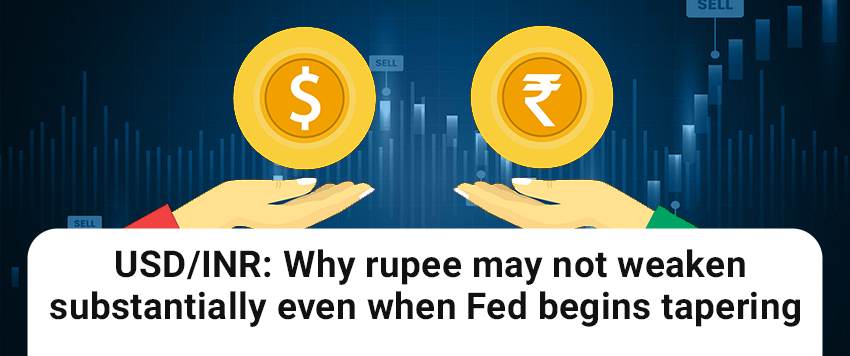USD/INR: Why rupee may not weaken substantially even when Fed begins tapering


The Indian rupee will likely trade in a stable range over the next year and is unlikely to depreciate substantially against the dollar even when the US Federal Reserve begins to wind down its monetary stimulus, a CLSA report says.
The rupee has gained in recent months to trade around 73.7 to a dollar last week after falling past 75 in April when India was in the grip of a brutal second wave of the Covid-19 pandemic. But talk of the Fed beginning to taper the stimulus it gave to revive the US economy if the pandemic subsides has raised concerns of its adverse impact on emerging economies, similar to the effect the 2013 ‘taper tantrum’ had on many countries including India.
However, CLSA analyst Indranil Sen Gupta said in a report titled ‘A virtuous INR cycle’ that India’s high foreign exchange reserves will guard against any speculative attacks on the rupee this time around.
The brokerage expectsthe rupee to trade in a range of Rs73-76.50 to one dollar in 2022-23 and says large depreciation, as seen in 2011, 2013 and 2018, is unlikely even if the Fed tapers.The brokerage expects rupee depreciation slowing to an average 2% a year from 5.2% in 2013-20.
A stable currency is important for foreign investment flows, both into equities and debt, as investors want to ensure their capital is not eroded by high depreciation. This is where high forex reserves become critical.
Why forex reserves are important to stabilise rupee
The rupee is vulnerable to speculative attacks because of India’s chronic and often large current account deficit. High forex reserves provide the comfort that the RBI will be able to fund any outflow without any runaway depreciation.
Traditionally, RBI has maintained that it intervenes in the forex market only to smoothen volatility. However, RBI governor Shaktikanta Das has shifted to an explicit policy of building forex reserves.
Indeed, the RBI has been building high forex reserves to stabilise rupee expectations. It has seized the opportunity offered by the surge in global liquidity, fall in oil prices and collapse in domestic import demand due to the Covid-19 shock. According to CLSA, the RBI has bought an estimated $180 billion in spot markets as well as in forwards since March 2020. India had forex reserves of about $641 billion as of last week.
“Under uncertain global economic environment, EMEs (emerging market economies) typically remain at the receiving end. In order to mitigate global spill-overs, they have no recourse but to build their own forex reserve buffers, even though at the cost of being included in currency manipulators list or monitoring list of the US Treasury,” Das said recently.
CLSA, however, says that while the US has put India on the currency manipulator watch list, it is unlikely the RBI will ever meet the three criteria for being actually marked as a currency manipulator. These parameters are: one, a bilateral trade surplus with the US of more than $20 billion; two, a current account surplus of at least 3% of gross domestic product (GDP); and three, net purchases of foreign currency of 2% of GDP over 12 months.
India has a trade surplus with the US, though not enough to meet the parameter cited above. Also, India has had traditionally a current account deficit, largely because of a high trade deficit, though the country had a surplus in 2020-21 as imports nosedived due to low crude oil prices and pandemic-related restrictions.
CLSA projects India’s current account deficit at -0.8% of GDP in 2021-22 and -1.2% in 2022-23 from a surplus of 0.9% in 2020-21 with the normalization of economic activity.
What will RBI do?
CLSA says it expects the RBI to keep buying dollars when the greenback weakens, but says forex reserves of around $600 billion are adequate for India as this would suffice for 10 months of imports. “We expect RBI Governor Das to continue to build FX reserves to guard against contagion in an uncertain world. The RBI should continue to buy FX reserves when the USD weakens. It will let the INR weaken when the USD strengthens,” the brokerage says.
According to CLSA, the RBI wouldn’t want rupee appreciation even though any appreciation will attract capital flows. This is because the rupee’s appreciation will lead to mark-to-market hits on the RBI balance sheet. Also, a weaker currency supports India’s exports.
However, the RBI wouldn’t want large-scale depreciation either. “We think that the RBI will not favour large-scale depreciation as that will hurt capital flows that are the mainstay of funding a chronic current account deficit,” CLSA says.
Share Market Today
| Indices Name | Price | Price Change (% change) |
|---|---|---|
| S&P ASX 200 | 7581.50 | -109.2 (-1.42%) |
| CAC 40 | 8088.24 | 71.59 (0.89%) |
| DAX | 18161.01 | 243.73 (1.36%) |
| Dow Jones | 38239.66 | 153.86 (0.4%) |
| FTSE 100 | 8145.02 | 68.42 (0.85%) |
| Hang Seng | 17651.16 | 366.61 (2.12%) |
| US Tech Composite | 15932.90 | 316.14 (2.02%) |
| Nikkei 225 | 37934.69 | 306.28 (0.81%) |
| S&P 500 | 5099.96 | 51.54 (1.02%) |
| Gift Nifty | 22638.00 | -35 (-0.15%) |
| Shanghai Composite | 3088.64 | 35.74 (1.17%) |
| Taiwan Weighted | 20120.51 | 263.09 (1.32%) |
| US 30 | 38305.90 | 180.7 (0.47%) |
Start Investing in 5 mins*
Rs. 20 Flat Per Order | 0% Brokerage
